Figure shows a potentiometer with a cell of 2.0 V and internal resistance 0.40Ω maintain a potential drop across the resistor wire AB. A standard cell which maintains a constant emf of 1.02 V (for very moderate currents upto a few mA) gives a balances point at 63.3 cm length of the wire. To ensure very low currents drawn from the standard cell, a very high resistance of 600Ω is put is series with it, which is shortedd close to the balance point. The standard cell is then replaced by a cell of unknown emf ε and the balance point found similarly, turns out to be at 82.3 cm length of the wire.

What purpose does the high resistance of 600 k Ω have?Solution in Telugu
The purpose of using high resistance of 600kΩ is to allow very small current through the galvanometer when the movalbe contact is far from the balance point.
Topper's Solved these Questions
- BOOK - VIKRAM PUBLICATION ( ANDHRA PUBLICATION)CHAPTER - CURRENT ELECTRICITY EXERCISE - TEXTUAL EXERCISES34videos
CURRENT ELECTRICITY
- BOOK - VIKRAM PUBLICATION ( ANDHRA PUBLICATION)CHAPTER - COMMUNICATION SYSTEMEXERCISE - TEXTUAL EXERCISES8videos
COMMUNICATION SYSTEM
- BOOK - VIKRAM PUBLICATION ( ANDHRA PUBLICATION)CHAPTER - DUAL NATURE OF RADIATION AND MATTEREXERCISE - DAM SURE (VSAQ)2videos
DUAL NATURE OF RADIATION AND MATTER
Similar Questions
The storage battery of a car has an emf of 12 V. If the internal resistance of the battery is 0.4Ω, what is the maximum current that can be drawn from the battery?
04:19View SolutionWhich of the following frequencies will be suitable for beyond the horizon communication using sky waves ?
03:06View SolutionThe wavelength of electromagnetic radiation is doubled. What will happen to the energy of the photons of the new radiation ?
04:23View SolutionFigure shows a potentiometer with a cell of 2.0 V and internal resistance 0.40Ω maintain a potential drop across the resistor wire AB. A standard cell which maintains a constant emf of 1.02 V (for very moderate currents upto a few mA) gives a balances point at 63.3 cm length of the wire. To ensure very low currents drawn from the standard cell, a very high resistance of 600Ω is put is series with it, which is shortedd close to the balance point. The standard cell is then replaced by a cell of unknown emf ε and the balance point found similarly, turns out to be at 82.3 cm length of the wire.
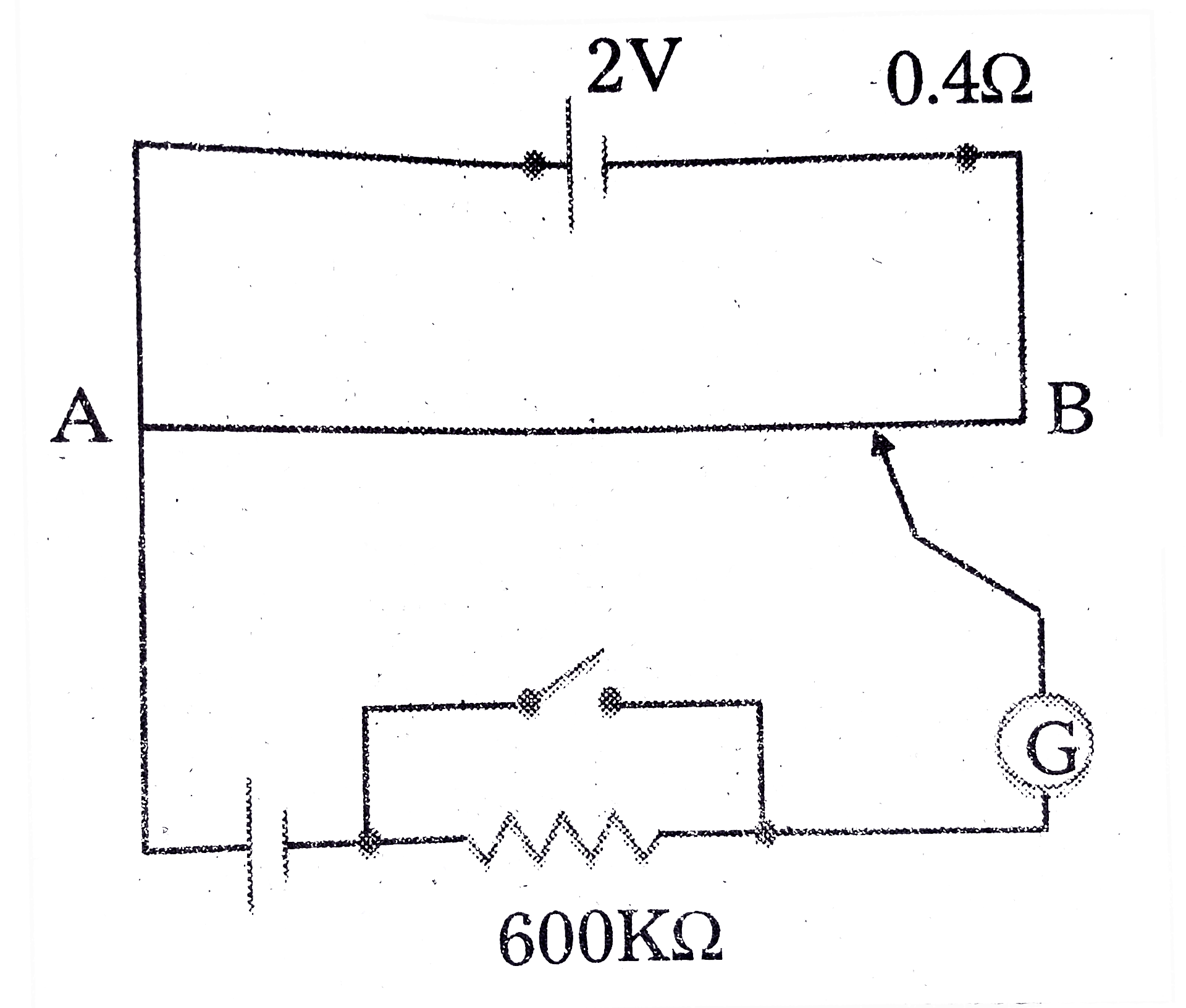
What is the value ε ?04:44View SolutionFigure shows a potentiometer with a cell of 2.0 V and internal resistance 0.40Ω maintain a potential drop across the resistor wire AB. A standard cell which maintains a constant emf of 1.02 V (for very moderate currents upto a few mA) gives a balances point at 63.3 cm length of the wire. To ensure very low currents drawn from the standard cell, a very high resistance of 600Ω is put is series with it, which is shortedd close to the balance point. The standard cell is then replaced by a cell of unknown emf ε and the balance point found similarly, turns out to be at 82.3 cm length of the wire.
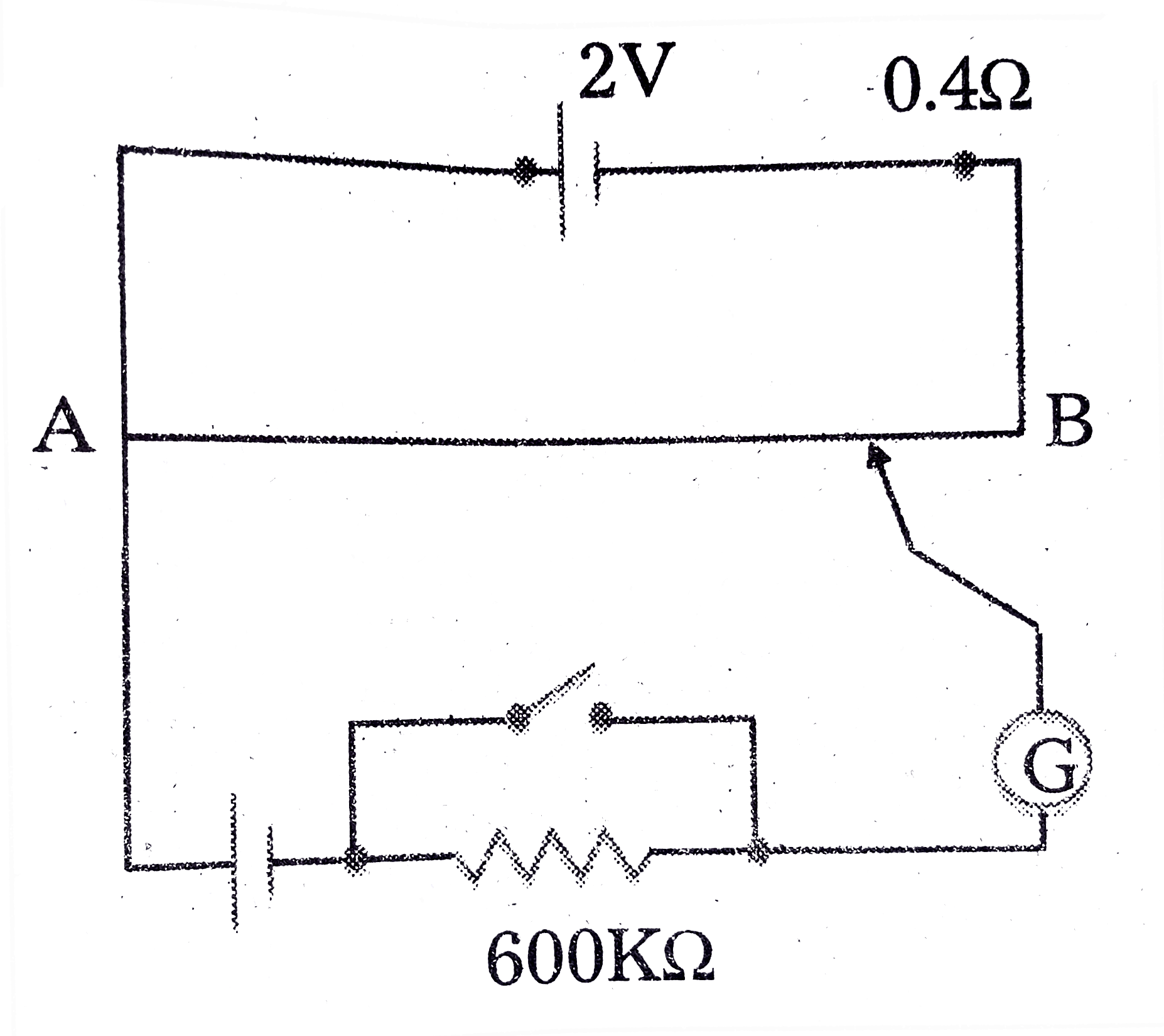
Is the balance point affected by this high resistance?04:59View SolutionFigure shows a potentiometer with a cell of 2.0 V and internal resistance 0.40 Omega maintain a potential drop across the resistor wire AB. A standard cell which maintains a constant emf of 1.02 V (for very moderate currents upto a few mA) gives a balances point at 63.3 cm length of the wire. To ensure very low currents drawn from the standard cell, a very high resistance of 600 Omega is put is series with it, which is shortedd close to the balance point. The standard cell is then replaced by a cell of unknown emf epsilon and the balance point found similarly, turns out to be at 82.3 cm length of the wire. Is the balance point affected by the internal resistance of the driver cell.
04:30View SolutionFigure shows a potentiometer with a cell of 2.0 V and internal resistance 0.40Ω maintain a potential drop across the resistor wire AB. A standard cell which maintains a constant emf of 1.02 V (for very moderate currents upto a few mA) gives a balances point at 63.3 cm length of the wire. To ensure very low currents drawn from the standard cell, a very high resistance of 600Ω is put is series with it, which is shortedd close to the balance point. The standard cell is then replaced by a cell of unknown emf ε and the balance point found similarly, turns out to be at 82.3 cm length of the wire.
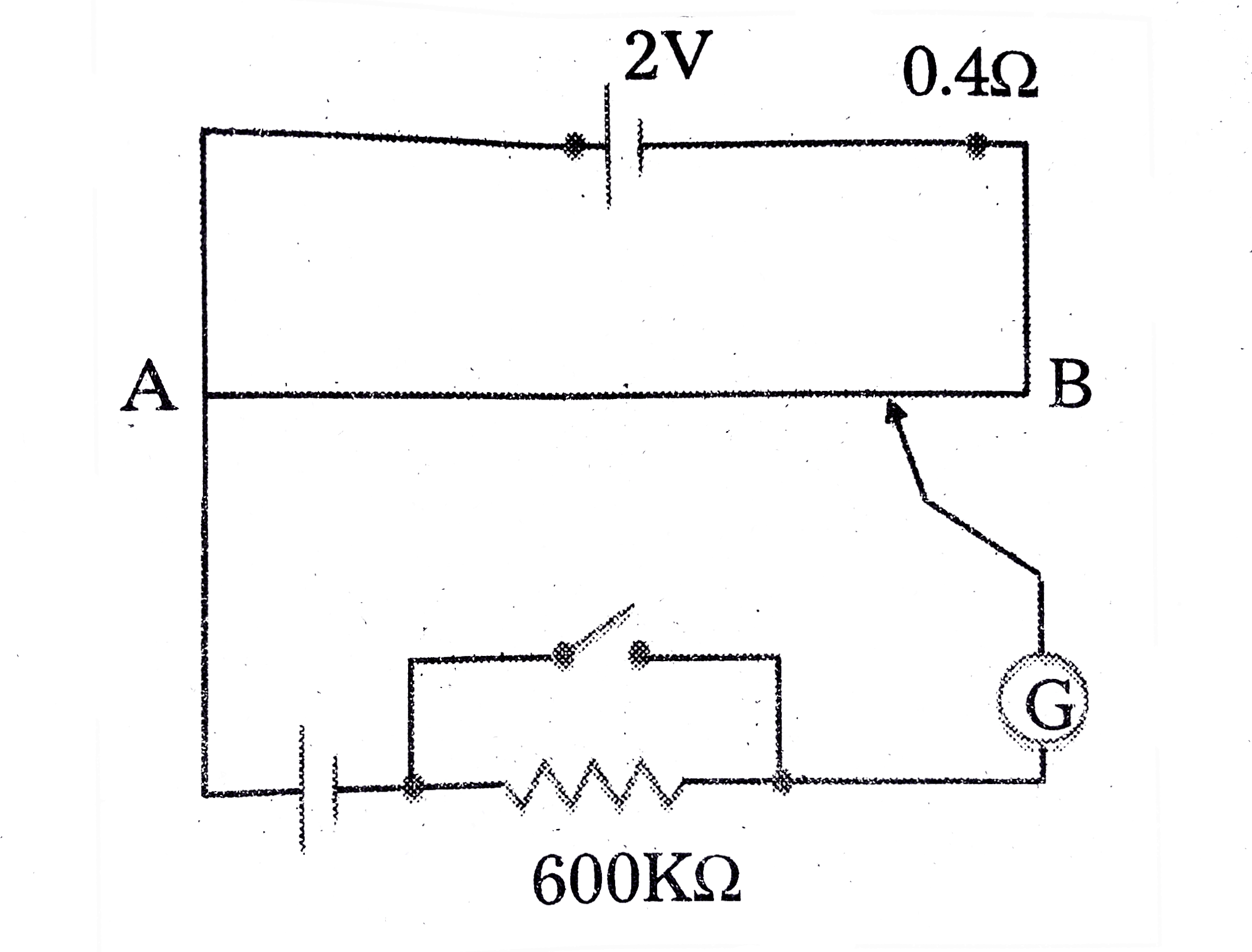
Would the method work in the above situation if the driver cell of the potentiometer had an emf of 1.0 V instead of 2.0 V?04:29View SolutionFigure shows a potentiometer with a cell of 2.0 V and internal resistance 0.40 Omega maintain a potential drop across the resistor wire AB. A standard cell which maintains a constant emf of 1.02 V (for very moderate currents upto a few mA) gives a balances point at 63.3 cm length of the wire. To ensure very low currents drawn from the standard cell, a very high resistance of 600 Omega is put is series with it, which is shortedd close to the balance point. The standard cell is then replaced by a cell of unknown emf epsilon and the balance point found similarly, turns out to be at 82.3 cm length of the wire. Would the circuit work well for determining an extermely small emf, say of the order of a few mV (such as the typcial emf a thermo-couple)? if not, how will you modify the circuit?
View Solutionचित्र में एक वोल्ट्मीटर दर्शाए गया है जिसमे एक 2.0V और आंतरिक प्रतिरोध 0.40Ω का कोई सेल वोल्ट्मीटर के प्रतिरोधक तार AB पर वोलटता पात बनाये रखता है । कोई मानक सेल जो 1.02 V का अचर विद्युत वाहक बल बनये रखता है ( कुछ mA की बहुत सामान्य धाराओं के लिए ) तार की 67.3 सेमी लम्बाई पर संतुलन बिंदु देती है । मानक सेल से अति न्यून धारा लेना सुनिश्चित करने के लिए इसके साथ परिपथ में श्रेणी 600kΩ का एक अति उच्च प्रतिरोध इसके साथ संबद्ध किया जाता है , जिसके संतुलन बिंदु प्राप्त होने के निकट लघुपथित (Shorted) कर दिया जाता है । इसके बाद मानक सेल को किसी अज्ञात विद्युत बल के सेल से प्रतिस्थापित कर दिया जाता है । जिससे संतुलन बिंदु तार की 82.3 सेमी लम्बाई पर प्राप्त होता है ।
(b ) 600kΩ के उच्च प्रतिरोध का क्या प्रयोजन है ?
 View Solution
View Solutionचित्र में एक वोल्ट्मीटर दर्शाए गया है जिसमे एक 2.0V और आंतरिक प्रतिरोध 0.40Ω का कोई सेल वोल्ट्मीटर के प्रतिरोधक तार AB पर वोलटता पात बनाये रखता है । कोई मानक सेल जो 1.02 V का अचर विद्युत वाहक बल बनये रखता है ( कुछ mA की बहुत सामान्य धाराओं के लिए ) तार की 67.3 सेमी लम्बाई पर संतुलन बिंदु देती है । मानक सेल से अति न्यून धारा लेना सुनिश्चित करने के लिए इसके साथ परिपथ में श्रेणी 600kΩ का एक अति उच्च प्रतिरोध इसके साथ संबद्ध किया जाता है , जिसके संतुलन बिंदु प्राप्त होने के निकट लघुपथित (Shorted) कर दिया जाता है । इसके बाद मानक सेल को किसी अज्ञात विद्युत बल के सेल से प्रतिस्थापित कर दिया जाता है । जिससे संतुलन बिंदु तार की 82.3 सेमी लम्बाई पर प्राप्त होता है ।
(d ) क्या संतुलन बिंदु चालक के सेल के आंतरिक प्रतिरोध से प्रभावित होता है ?
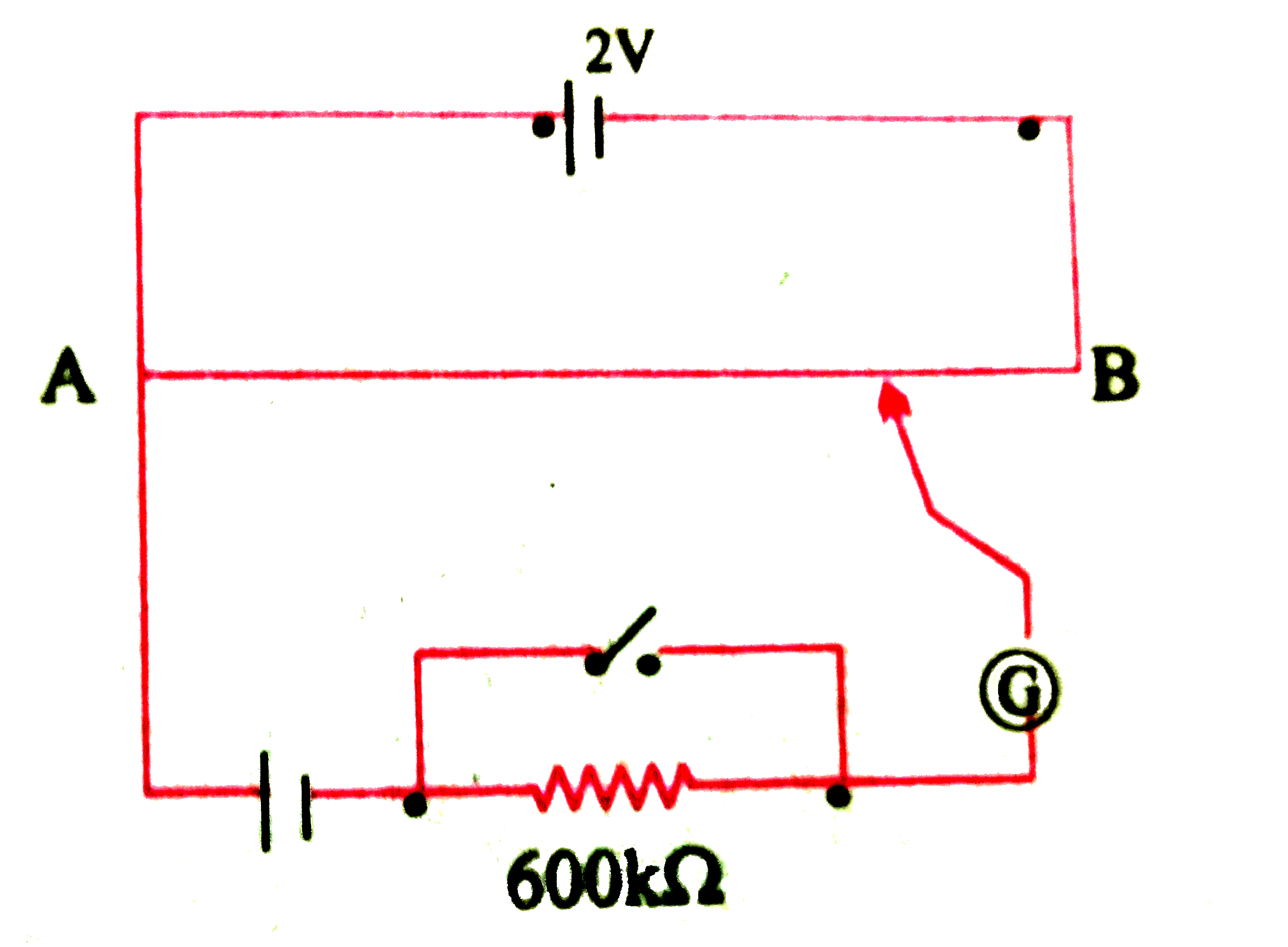 View Solution
View SolutionFigure shows a potentiometer with a cell of 2.0 V and internal resistance 0.40 Omega maintaining a potential drop across the resistor wire AB. A standard cell which maintains a constant emf of 1.02 V (for every moderate currents upto a few mA) gives a balance point at 67.3 cm length of the wire. To ensure very low currents drawn from the standard cell, a very high resistance of 600 Omega is put in series with it, which is shorted close to the balance point. The standard cell is then replaced by a cell of unknown emf epsi and the balance point found similarly, turns out to be at 82.3 cm length of the wire. What is the value epsi ?
04:17View SolutionFigure shows a potentiometer with a cell of 2.0 V and internal resistance 0.40 Ω maintaining a potential drop across the resistor wire AB. A standard cell which maintains a constant emf of 1.02 V (for every moderate currents upto a few mA) gives a balance point at 67.3 cm length of the wire. To ensure very low currents drawn from the standard cell, a very high resistance of 600 Ω is put in series with it, which is shorted close to the balance point. The standard cell is then replaced by a cell of unknown emf ε and the balance point found similarly, turns out to be at 82.3 cm length of the wire.
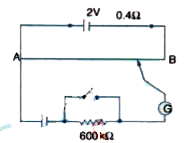
What purpose does the high resistance of 600 K Ω have ?03:42View SolutionFigure shows a potentiometer with a cell of 2.0 V and internal resistance 0.40 Omega maintaining a potential drop across the resistor wire AB. A standard cell which maintains a constant emf of 1.02 V (for every moderate currents upto a few mA) gives a balance point at 67.3 cm length of the wire. To ensure very low currents drawn from the standard cell, a very high resistance of 600 Omega is put in series with it, which is shorted close to the balance point. The standard cell is then replaced by a cell of unknown emf epsi and the balance point found similarly, turns out to be at 82.3 cm length of the wire. Would the method work in the above situation if the driver cell of the potentiometer had an emf of 1.0 V instead of 2.0 V?
03:07View SolutionFig. shows a potentiometer with a cell of 2.0V and internal resistance 0.40Omega maintaining a potential drop across the resistor wire AB. A standard cell which maintains a constant emf of 1.02V (for very moderate currents upto a few pA) gives a balance point at 67.3 cm length of the wire. Io ensure very low currents drawn from the standard cell, a very high resistance of 600kOmega is put in series with it which is shorted close to the balance point. The standard cell is then, replaced by a cell of unknown emf e and the balance point found similarly turns out to be at 82.3 cm length of the wire, What purpose does the high resistance of 600kOmega have?
03:51View SolutionFig. shows a potentiometer with a cell of 2.0V and internal resistance 0.40Ω maintaining a potential drop across the resistor wire AB. A standard cell which maintains a constant emf of 1.02V (for very moderate currents upto a few pA) gives a balance point at 67.3 cm length of the wire. to ensure very low currents drawn from the standard cell, a very high resistance of 600kΩ is put in series with it which is shorted close to the balance point. The standard cell is then, replaced by a cell of unknown emf e and the balance point found similarly turns out to be at 82.3 cm length of the wire,
Is the balance point affected by this high resistance?
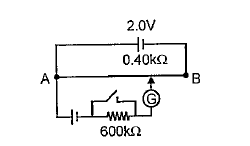 03:07View Solution
03:07View Solution

